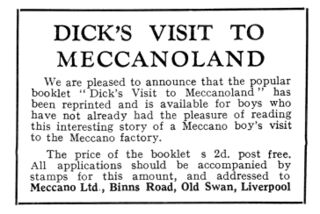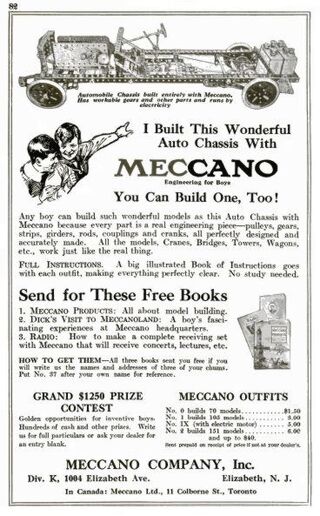Meccanoland
"Dick's Visit to Meccanoland", small-ad in Meccano Magazine advertising the reprint of the booklet (1929) [image info]
Meccanoland was a concept repeatedly referred to in Meccano Magazine and in Meccano Ltd.'s literature. It was used variously to refer to
- A fictitious visited land inhabited by Meccano creatures (Meccanitians) similar in concept to Wonderland in "Alice in Wonderland", Never-never-land in "Peter Pan" and Liliput in "Gulliver's Travels".
- An exalted state of existence inhabited by Meccano enthusiasts whose "citizens" had a common set of values based on the importance of learning and internal discipline (and using Meccano), and
- The Meccano Ltd. Factory at Binns Road, the source of all things Meccano.
Meccanoland and the Meccanitians
Meccanoland featured in the titles of a series of articles in Meccano Magazine. My Adventures in Meccanoland (December 1918, May and September 1919) dealy with life as a Meccano enthusiast, Further Adventures in Meccanoland (September and October 1924) dealt mostly with competition entries, many of which were increasingly focused on small figures and animals, which set the scene for Discoveries in Meccanoland(December 1924 and January 1925), which described and illustrated the inhabitants of a whimsical fantasy land inhabited by little Meccano people known as Meccanitians (led by "King Meccano".
"Meccanoland" pantomime shows
The "Meccanoland" concept translated easily to children's pantomime, as it allowed a narrative structure in which a child is transported to a similar-yet-different world (Meccanoland) where they meet unusual creatures and have adventures before returning - "Meccanoland" lent itself to a similar storytelling structure to Alice in Wonderland or The Wizard of Oz.
Meccanoland also had the advantages that the structures of the fantasyland were already familiar to children, and the writers were free to come up with almost any story set within Meccanoland without having to follow the constraints of an existing plot (which also gave them freedom to modify their story as needed). Additionally, the set design for these shows was very, very easy, as all one really had to do was scale up standard Meccano parts and use them to dress the stage to create a world that – unusually for pantomime – could appear convincingly authentic and genuinely surreal.
Pantomime producer Julian Wylie found that adding a "Meccanoland" scene was an easy and distinctive way to extend a pantomime's plot, and added Meccanoland scenes and scenery to several productions.
- 1917: Palace Theatre, Manchester, "Babes in the Wood" panto, "Meccanoland" scene
- 1926: Empire Theatre, Liverpool, "The Sleeping Beauty", "Meccanoland" scene
- 1929: Drury Lane, London, "The Sleeping Beauty", Meccanoland scene
- 1930: Palace Theatre, Manchester, "Dick Whittington", Meccanoland scene
- 1931: Theatre Royal, Glasgow "Dick Whittington", Meccanoland scene
- 1933: King's Theatre, Edinburgh, "The Sleeping Beauty", Meccanoland scene
"Dick's Visit to Meccanoland"
US advert for Meccano, announcing free copies of "Dick's Visit to Meccanoland", Popular Mechanics, 1922 [image info]
"Dick's Visit to Meccanoland" was a small promotional booklet produced by Meccano Ltd., and given away by mail-order as a way of promoting the company, and the philosophy of Meccano.
The structure of the story concerns a father who, on playing with Meccano with his son Dick, decides to take Dick to the Binns Road factory to meet Frank Hornby, who shows the pair the Meccano design room, and then explains the principles and philosophy of the toy.
"Dick's Visit" is obviously written as a promotional piece (to the extent that at some points, it seems to modern eyes to descend into advertising parody), but this was, after all, a free promotional publication. Interestingly, the main protagonist of the piece, other than "Mr Hornby" is not Dick, but his father, perhaps reflecting Hornby's understanding that for a fairly expensive toy, it was important to win over the person who would actually be asked to pay for it. With most of the conversations in "Dick's Visit" taking place between Mr Hornby and the father, the piece gave Frank Hornby an ideal platform to espouse his personal views of the importance and potential of Meccano as an influence on children's development, in response to the parent asking a very convenient set of questions that Mr. Hornby was then only too willing to answer.
The piece ends with the parent reflecting on the wondrousness of the encounter:
- " Friend Hornby! If you could talk to all fathers in this great country as you talked to me; if only parents could be brought to realise what a wonderful medium they have in your toy for developing and strengthening the minds of their children – for bringing out initiative and inventiveness; for filling their brains with keen, ambitious and wholesome thoughts – what a nation of supermen our future rulers and workers would be. "
Reprinting and republication
"Dick's Visit" was expanded and reprinted in 1922, and was then serialised in Meccano Magazine in March, April, May and June 1925, as four two-page chapters.
External links and references
Meccanoland as Binns Road:
- "Duke of York Visits Meccanoland: A Hornby Train for Princess Elizabeth" Meccano Magazine July 1930, pages 546-547, 592.
- "South African Cricket Team Visit Meccanoland" Meccano Magazine October 1929, pages 784-785.





